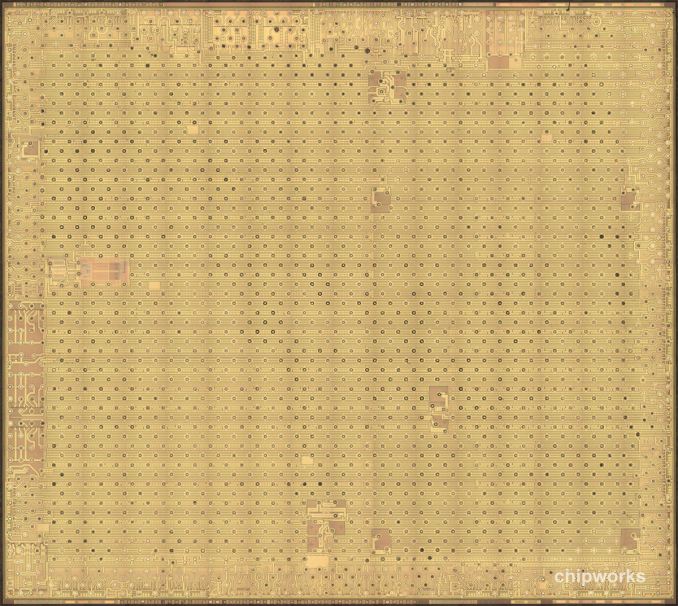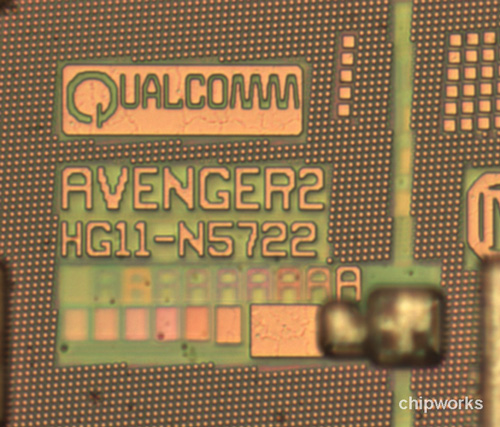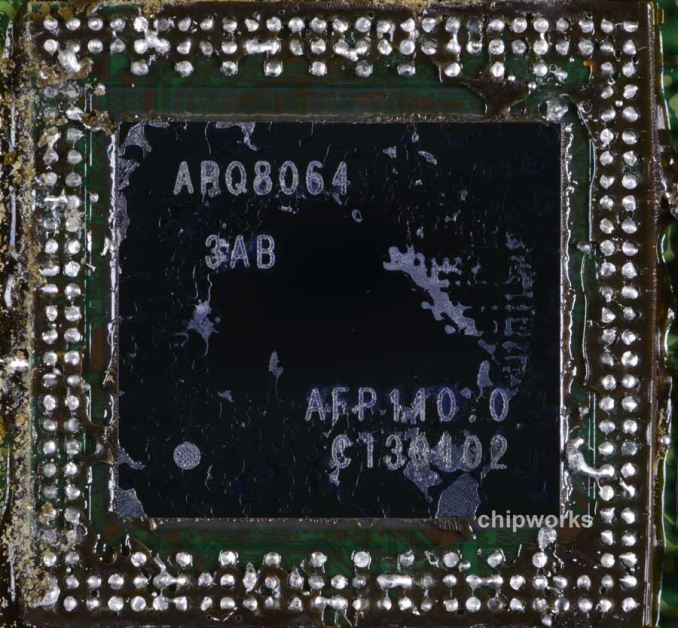Samsung Galaxy S 4 Review - Part 1
by Brian Klug on April 24, 2013 12:01 AM ESTGalaxy S 4 - Powered by a Better Snapdragon 600 (APQ8064AB)?
At a high level, Samsung's Galaxy S 4 integrates Qualcomm's Snapdragon 600 SoC. From what Qualcomm told us about Snapdragon 600, we're dealing with four Krait 300 cores and an Adreno 320 GPU. The Krait 300 cores themselves are supposed to improve performance per clock over the original Krait CPU (Krait 200) through a handful of low level microarchitectural tweaks that we've gone through here. The Krait 300 design also allegedly improves the ability to run at higher frequencies without resorting to higher voltages. This isn't the first time we've talked about Snapdragon 600, but since then a few things have come to light.

Snapdragon 600 from HTC One - Chipworks
For starters, Chipworks got their hands on a Snapdragon 600 SoC (from an HTC One) and delayered the SoC. In its investigation, Chipworks discovered that Snapdragon 600 had the exact same die area as the previous generation Snapdragon S4 Pro (APQ8064). Also, although you'd expect APQ8064T markings on the chip itself, the part carried the same APQ8064 label as previous S4 Pro designs.

Avenger 2 Markings on Snapdragon 600 die from HTC One - Chipworks
Chipworks did note however that there were some subtle differences between a standard APQ8064 and the Snapdragon 600 SoC from the HTC One. The Snapdragon 600 from the One is labeled with an Avenger2 codename rather than Avenger, the latter was apparently present on prior APQ8064 designs. Chipworks also noticed differences in the topmost metal layer, although it's not clear whether or not they stopped there or found no differences in lower layers.
All of this points to a much more subtle set of physical differences between APQ8064 and the earliest Snapdragon 600s. Metal layer changes are often used to fix bugs in silicon without requiring a complete respin which can be costly and create additional delays. It's entirely possible that Krait 300 was actually just a bug fixed Krait 200, which would explain the identical die size and slight differences elsewhere.
That brings us to the Galaxy S 4. It's immediately apparent that something is different here because Samsung is shipping the Snapdragon 600 at a higher frequency than any other OEM. The Krait 300 cores in SGS4 can run at up to 1.9GHz vs. 1.7GHz for everyone else. Curiously enough, 1.9GHz is the max frequency that Qualcomm mentioned when it first announced Snapdragon 600.
Samsung is obviously a very large customer, so at first glance we assumed it could simply demand a better bin of Snapdragon 600 than its lower volume competitors. Looking a bit deeper however, we see that the Galaxy S 4 uses something different entirely.
APQ8064 from a Snapdragon 600 based HTC One - Chipworks
Digging through the Galaxy S 4 kernel source we see references to an APQ8064AB part. As a recap, APQ8064 was the first quad-core Krait 200 SoC with no integrated modem, more commonly referred to as Snapdragon S4 Pro. APQ8064T was supposed to be its higher clocked/Krait 300 based successor that ended up with the marketing name Snapdragon 600. APQ8064AB however is, at this point, unique to the Galaxy S 4 but still carries the Snapdragon 600 marketing name.
If we had to guess, we might be looking at an actual respin of the APQ8064 silicon in APQ8064AB. Assuming Qualcomm isn't playing any funny games here, APQ8064AB may simply be a respin capable of hitting higher frequencies. We'll have to keep a close eye on this going forward, but it's clear to me that the Galaxy S 4 is shipping with something different than everyone else who has a Snapdragon 600 at this point.











335 Comments
View All Comments
mayankleoboy1 - Wednesday, April 24, 2013 - link
1. Out of the box, how does SGS4 display compare to HTC one ?2.This review feels a bit cramped, mainly because Samsung/QC hasnt given much info on the SoC. (To be clear, the reviewer cant do much here).
netmann - Wednesday, April 24, 2013 - link
Apple iPhone 5, Google Nexus 4, HTC One, Samsung Galaxy S4....they all being reviewed at AnandTech while Nokia Lumia 920 keep getting ignored!?aelwyn - Wednesday, April 24, 2013 - link
Because, with the exception of the iPhone, they're comparing Android phones. People interested in the S4 are probably not even considering a Windows phone. The iPhone is included simply because, right or wrong, it's the benchmark against which other smartphones are measured.kyuu - Wednesday, April 24, 2013 - link
He was talking about the phones actually getting reviewed, not their inclusion or exclusion from the charts in this article.Quite a while ago a Lumia 920 review was supposed to have been in the works, but it never materialized and I have never seen an explanation for why it was (apparently) canned. Maybe we'll get a review of the 928, which, despite a few change-ups, is largely identical.
maximumGPU - Thursday, April 25, 2013 - link
indeed, we were promised a 920/HTC 8X review and never got one. I think it's a bit unfair towards the windows phone community.jeffkibuule - Thursday, April 25, 2013 - link
Windows Phone 8X: http://www.anandtech.com/show/6692/from-mango-to-a...I think what you really want is an in depth review of the 920, but from a hardware standpoint, there's little remarkably new about either when it was released or now. Perhaps it would have been more honest to have a review of Windows Phone 8 in general, but there's not much new to show for it.
val580 - Wednesday, April 24, 2013 - link
18 unread sms and 23 missed calls :-) wish I had that number of girlfriends lolbmgoodman - Wednesday, April 24, 2013 - link
Many of you will regret buying this phone with Android 5 rolling out in the coming weeks! Trust me, as a Galaxy S2 owner, I know only too well how many upgrades that Samsung/AT&T combined to totally bork my phone! The worst was the "Sleep of Death" that was added in 4.0.4 and took nearly 4 months to correct. Then there were other "features", like not reconnecting to the wifi after waking the phone, potentially using LOTS of extra data from your cellular data plan. Samsung has also stopped providing technical information to the developer community and many of the custom ROM developers are giving up. There is *still* not a stable version of CyanogenMod based on Android 4.1 for the Galaxy S2, for example.Sure, there's a lot I love about my phone, but I'm reluctant to buy another Samsung. That said, if you're happy with 4.2.2, and you can manage to keep Samsung from "upgrading" you, you may well be pleased with the phone for a few years. (I won't even get into hardware reliability, other than to say that my phone is now exhibiting some strange minor Bluetooth issues.)
Gray05 - Wednesday, April 24, 2013 - link
If you don't run custom ROMs, you are likely going to wait a long time to get updates. And just like the version the phone ships with, the updates suck. That is reality. From what I see, that is independent of what carrier/OEM you use.If you insist on using CyanogenMod as your ROM, ok. But there are plenty of stable ROMs out for the S2.
sigmatau - Thursday, April 25, 2013 - link
I am extremely leery about Samsung. I've owned a GS2 and hated it. It had a hesitation issue with the UI and I have noticed it in the GS3 too. I find it annoying having to wait for it to flip my screen when I want to type an email. It seemed like a second too late and I found myself shaking the phone to try to activate it. The lock screen was beyond stupid where you couldn't set a time before it would ask for your PIN. There were the options in the settings, but they didn't work.And don't start me on the fail built in email. I use my phone for work and find myself typing many emails on it. My GS2 would crash so much during email typing that I had to throw it one day. So much lost time on that POS. Samsung also took about a year to upgrade it to ICS even though it came out a month after the US's release.
Then there were random times that my SD card would be wiped randomly and all my music with it. It's fairly annoying having to reload almost 20 GBs of music on those slow memory sticks.